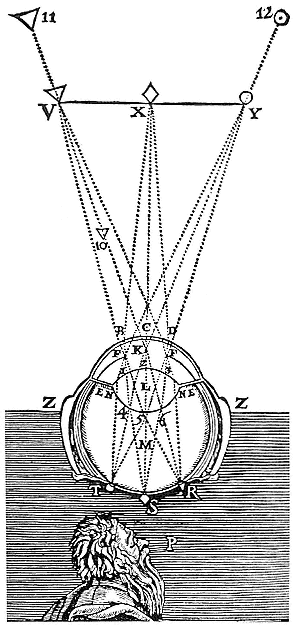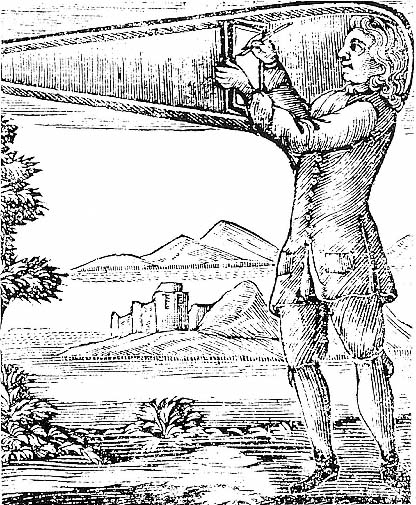1—
For the recurring relationships between image making and visual perception, I have coined the expression "visualization of sight" and applied it in two different but clearly related senses. In its primary sense it refers to pictures ("still" or "moving," drawn or painted or photographed) that are intended to be equivalents of our actual experience of seeing. This is what Joel Snyder has called "picturing vision."[1] The softly glowing, barely distinguishable shapes in Monet's Water Lilies and the sharply focused,
immediately recognizable images of human forms and architectural spaces in Raphael's The School of Athens are both visualizations of sight because both represent what their makers believed to be pictures of what the eye actually sees.
In its secondary sense, visualization of sight refers to diagrams, models, and instruments of various sorts that reveal something about how sight occurs, whether or not they were originally intended for that purpose. In one way or another they give visible form to some aspect of the processes that produce sight. Let us begin with examples of this kind of visualization of sight, because in them we can see how models of how we see have influenced the efforts to picture what we see.
Our first example is familiar to anyone who has studied visual perception. It shows a schematized eyeball and a man scrutinizing the retina from the darkness behind the eye. It first appeared in René Descartes's treatise on optics and vision, La Dioptrique , published in 1637, and was intended to illustrate the formation of the retinal image. In Descartes's illustration the retinal image is produced by light rays entering the eye through the pupil and converging on the retina, where they form an inverted image of the sources outside the eye. Granting its schematic simplifications, the illustration is essentially accurate, which is why, presumably, it continues to appear in modern works on visual perception.
But what is the reason for including that man in the dark staring at the back of the eyeball? He has nothing to do with the formation of the retinal image, and we know Descartes did not subscribe to the naive theory that some sort of homunculus in the brain looks at the images on the retina and somehow lets the mind know what it sees there. Who is that man, then, and what is he doing?
One answer is fairly simple. He represents anyone who might perform an experiment that was first carried out by the German priest Christopher Scheiner in 1619, which Descartes describes in detail in La Dioptrique . The eye of a recently dead human or large animal, such as an ox, is carefully removed, and the membranes covering the back of the eye cut away without allowing the vitreous humor to spill out. Then a piece of thin paper or eggshell is placed where the membranes have been removed and the eye inserted into the hole of a special shutter so that the pupil faces the outdoors and the back of the eye is in a totally darkened room. "When this has been done," Descartes writes, "if you look at that white body . . . [the area where paper or eggshell has replaced the retina], you will see there, not perhaps without admiration and pleasure, a picture which will represent in natural perspective all the objects which will be outside of it."[2]

The formation of the retinal image,
as illustrated in René Descartes's La Dioptrique (1637).
Descartes goes on to note that by squeezing the eyeball slightly and thereby making it a bit longer, one can adjust the focus for objects brought nearer to the eye.
From a modern point of view, the eyeball is like a miniprojection system with adjustable focus and a built-in rear-projection screen on which images of the outside world appear for the "admiration and pleasure" of its one-person audience in the darkened room. From Descartes's point of view, however, the chief value of the experiment was to demonstrate empirically that "the objects we look at do imprint very perfect images on the back of our eyes."[3]
When Descartes wrote La Dioptrique , the retinal image was still a new concept in theories of visual perception, its existence having been documented only thirty-three years earlier in Kepler's Ad Vitellionem Paralipomena (1604). Although Kepler left it to others to figure out what happens beyond the retina, he established the retinal image as the nexus between the world of light and the dark processes of the brain from which our perception of the visual world emerges.
In ancient and medieval theories of vision, there was no intervening "picture." The eyes simply served as conduits for rays (of what nature and from what source were questions never satisfactorily answered) that permitted the brain to perceive the world. Ironically, perhaps, modern theories have come back to a somewhat similar view. As mentioned in chapter 1, the retinal image has been relegated to a relatively minor role in seeing, compared with the "grand scheme" of electrochemical impulses that begin with the play of light on the rods and cones and culminate in the brain cells that give us the sensation of sight. Nevertheless, Kepler's theory and the experiments of Scheiner and Descartes correctly emphasized the fact that a picture (or more precisely a nearly infinite sequence of pictures) stands between the world and our perception of it.
Kepler, in fact, used the term pictura to describe the image on the retina, and this was, as David C. Lindberg has pointed out, "the first genuine instance in the history of visual theory of a real optical image within the eye—a picture , having an existence independent of the observer, formed by the focusing of all available rays on a surface."[4] Lindberg's way of putting it certainly suggests analogies with the images in the modern photographic camera, but of course a much older camera, the camera obscura , fits the analogies equally well.
Originally the camera obscura was a dark room with a small hole in the roof or wall, through which an image from outside the room fell on a wall or screen opposite the hole. It seems to have been used primarily for
observing eclipses of the sun and for conducting experiments in optics. With more sophisticated versions of the camera obscura came a greater interest in the images themselves, and that interest led to the recognition that the camera obscura and the eye have certain image-making properties in common. Leonardo da Vinci appears to have been the first person to draw analogies between the camera obscura and the eye—which means that Leonardo's long list of accomplishments should include the invention of the camera-eye metaphor.[5]
Leonardo may have invented the metaphor, but Descartes more fully explored its implications. In La Dioptrique he argues that the images on the retina are like "images that appear in a chamber, when having it completely closed except for a single hole, and having put in front of this hole a glass in the form of a lens, we stretch behind, at a specific distance, a white cloth on which the light that comes from the objects outside forms these images." Descartes then compares the camera obscura to the eye: "The chamber represents the eye; this hole, the pupil; this lens, the crystalline humor, or rather, all those parts of the eye which cause some refraction; and this cloth, the interior membrane, which is composed of the extremities of the optic nerve [the retina]."[6] His experiment with the eyeball, Descartes explains, should make "more certain" that analogies between the camera obscura and the eye are accurate and appropriate.
Thus, by the early seventeenth century, the camera obscura had been recognized as an image-making instrument analogous to the eye. Both were dark chambers with a small aperture opposite a "screen" that received images produced by light passing through the aperture. (Although a lens was commonly present, it was not essential for the production of an image.) Both produced images that could be observed from the darkness behind the "screen," and because the images in both cases were two-dimensional projections of the three-dimensional world they had a distinctly pictorial quality.
Because of their pictorialness, the projected images had the potential of being transformed into literal pictures. Leonardo notes that when the images are received on a very thin white paper and viewed from behind, they appear in their "proper forms and colors," and "will seem actually painted on this paper."[7] It is not known who took the first step from merely observing that pictorial quality to actually reproducing it, but by the middle of the seventeenth century a number of ingenious devices had been developed for making pictures directly from the projected image on the translucent screen of the camera obscura .[8] Whether used for artistic

A small, portable camera obscura designed by Robert Hooke (1694).
From Philosophical Experiments and Observations (1726).
purposes or simply as visual records of places and things, these copies implicitly emphasized the pictorial qualities of the image in the camera obscura and by analogy the same pictorial qualities of the image on the retina.
As early as 1637 (the same year as the publication of Descartes's La Dioptrique ) Pierre Hérigone, a French mathematician, made the pictorialness of the retinal image explicit. "Vision," he wrote, "is the percep-
tion of the image of the object painted on the retina."[9] The notion of an image "painted on the retina" became a commonplace of seventeenth- and eighteenth-century theories of visual perception. At the same time, it was argued that since we do not normally perceive the world as a two-dimensional image flitting over a curved surface, there must be other, nonvisual factors such as touch, kinesthetic experience, memory, and other thought processes that contributed to our perception of a solid, stable, three-dimensional world.[10] In other words, the very qualities that draw attention to the pictorialness of the retinal image and suggest analogies between the picture "painted on the retina" and the picture in the camera obscura are also the qualities that distinguish the picture from the visible world it is a picture of.
A way out of that paradoxical situation was offered by the theory and practice of pictorial perspective, in which space as depicted is intended to represent space as perceived in the everyday visual world. Descartes had noted that the image on the simulated retina of the eyeball appeared "in natural perspective," and many people commenting on the images in the camera obscura had said the same thing. For example, Descartes's contemporary Daniel Barbaro alled the camera obscura a "natural means for showing perspective" and concluded a long description of the camera obscura by remarking, "Seeing, therefore, on the paper the outline of things, you can draw with a pencil all the perspective and shading and coloring according to nature."[11] By the time of Descartes and Barbaro, it was commonly assumed that since nature is three-dimensional, the rules of perspective offered a natural means of representing the three-dimensionality of the real world on the two-dimensional plane of a picture. This assumption seemed to be supported by scientific evidence as well as aesthetic practice. It also carried significant if less obvious ideological implications, which helps to explain why it exerted so much influence on visualizations of sight—and why, therefore, we must examine the specific mechanisms of that influence in painting, photography, and filmmaking.